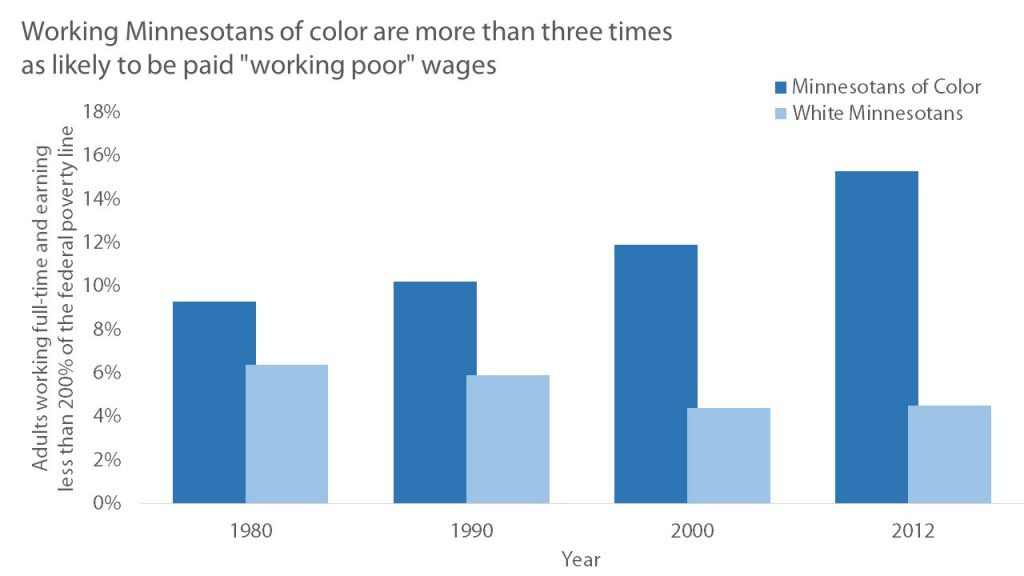Most people believe that full-time work should empower somebody to fill their fridge, fill their gas tank and start putting some money in the bank. That belief is less likely to match reality if you are a worker of color in Minnesota.
A new analysis from PolicyLink and the University of Southern California Program for Environmental and Regional Equity shows that working Minnesotans of color were 50 percent more likely to be considered “working poor” in 2012 than they were in 1980. Over the same time frame, the percentage of white working Minnesotans in the same category actually decreased.
PolicyLink defines the working poor as those who are working full time and whose household income is less than twice the federal poverty guidelines. That’s because the federal poverty guidelines generally fall short of describing what a family actually needs to make ends meet. For example, a single parent with a child who earns 200 percent of the federal poverty guideline, or about $32,000, falls $1,700 to $30,000 per year short of what it takes to meet a basic-needs budget in Minnesota depending on their county of residence.

Source: PolicyLink/PERE National Equity Atlas analysis using IPUMS; details, including a further breakdown by race and ethnicity, are available at the National Equity Atlas.
When you’re working hard but aren’t paid enough to make ends meet, the results of one misfortune can quickly compound. For example, if your car breaks down and you haven’t got the cash on hand to fix it, you might miss work. At best, the missed hours and auto repair bill may require temporary sacrifices like skipping a few meals. At worst, a missed workday can mean losing your job, likely sending your family into a downward economic spiral.
The impact of living on the economic margins is well-documented in social research. When keeping a roof over your head is a daily struggle, toxic stress accumulates and can even impact children’s brain development. On the other hand, when families’ economic resources increase, children are more likely to succeed in school and, later, in the workforce.
We must do more to make sure hard work pays off by improving job quality standards and supporting low-wage workers so that they can climb into the middle class, regardless of where their economic journey started. If Minnesota’s economy is going to continue to thrum at a level that makes it one of the strongest in the nation, we need to address structural racism, institutionalized in many cases by policies that governed (and in some cases, still govern) the workplace, the housing market, the criminal justice system and other elements of our society.
While there are no quick fixes that will mend these gaps in our economy, there are important steps we can take. PolicyLink has long researched and advocated for policies that would move the country towards a more equitable economy. Closer to home, Minnesota’s own Voices for Racial Justice tracks proposed legislation that would specifically address equity issues in our backyard.
Over the past year, more policymakers recognized the need for focused and direct attention to racial equity. They took a step in the right direction by funding initiatives in this year’s supplemental budget that specifically address racial equity. For further progress to be made, Minnesota’s conversation about building an equitable economy needs to continue — and we need to make sure that the people invited to the table represent the diverse strengths and backgrounds of our state.
-Ben Horowitz